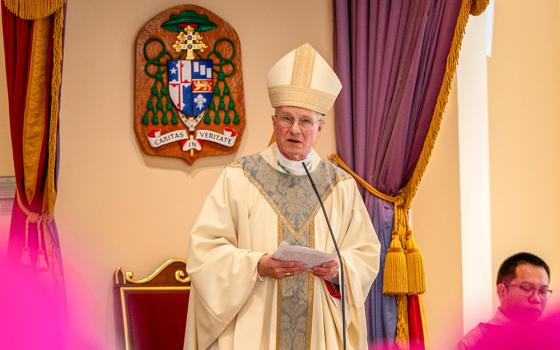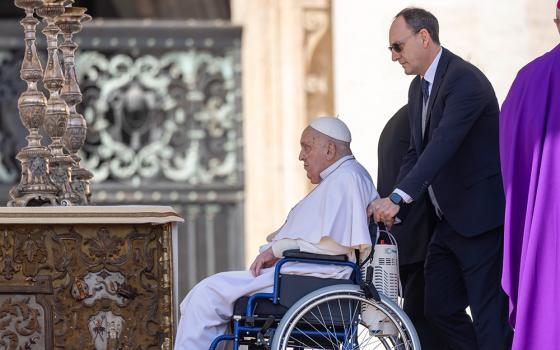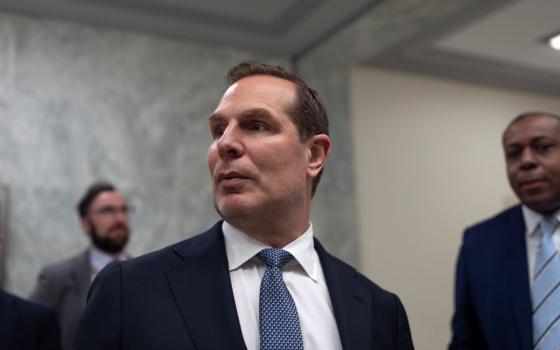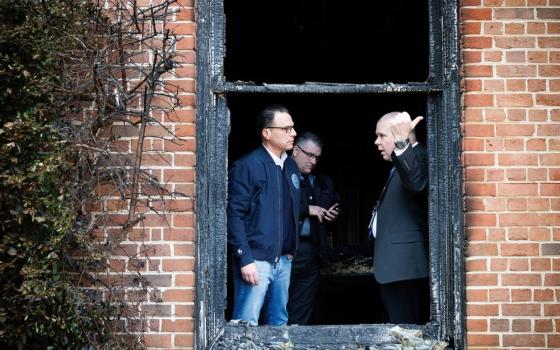A land bridge crossing for wildlife over Interstate 90 is seen near Snoqualmie Pass, Wash., Oct. 30, 2019. (OSV News/Washington State Department of Transportation/Handout via Reuters)
A long-standing joke asks why the chicken crossed the road, with the obvious and slightly amusing rejoinder, "To get to the other side." But the chance meeting of animals and autos is no laughing matter, as the World Wildlife Fund points out: "Vehicles collide with large animals 1-2 million times every year in the U.S., resulting in more than $8 billion in costs and 200 human deaths."
One solution — that both respects the Catholic Church's call to care for creation, while recognizing the human need for mobility — is the construction of wildlife crossings, land bridges offering animals safe passage over or under busy roads and highways.
The largest wildlife crossing in the world — the Wallis Annenberg Wildlife Crossing, christened after the foundation providing major funding — has just begun construction in Agoura Hills, California, some 30 miles west of Los Angeles. Straddling the 101 Freeway — one of the most congested freeways in the nation — the project should be completed by 2026.
"What I truly love about the Wallis Annenberg Wildlife Crossing isn't really its physical size, but its large impact in inspiring a new age of wildlife crossings," said Beth Pratt, regional executive director of the National Wildlife Federation's California Regional Center. "If the Los Angeles area can do it, nowhere else has any excuse."
There are some 1,500 wildlife crossing structures in 43 U.S. states, which may at first sound impressive. However, according to the U.S. Department of Transportation, there are also more than 4 million miles of American highways and roads.
"Truly, it all comes down to funding," Pratt explained. "Although government agencies are starting to include these in budgets, we are just not there yet to reach a critical mass."
Noting the expense of vehicle collisions with wildlife, Pratt said, "If we invested even a fraction of that amount annually, we would be able to start accelerating these projects, and also help save money by avoiding these collisions in the first place."
The Federal Highway Administration's Wildlife Crossings Pilot Program — established under the 2021 Bipartisan Infrastructure Law — has that very aim; the law authorized $350 million in funding from 2022 through 2026.
In mid-April, the Utah Department of Transportation nixed a wildlife crossing on the highway leading into Park City, a stretch of road the advocacy group Save People Save Wildlife said 30,000 cars travel each day. A UDOT official stated the agency is nonetheless "committed to looking at other potential solutions, while cutting down on wildlife-vehicle collisions."
"To get developers to take account of animals — and wildlife in particular — is always an uphill battle," noted Chris Fegan, chief executive of the U.K.-based Catholic Concern for Animals, which operates worldwide and traces its roots to 1929.
Advertisement
"Across the world, development is taking place in areas where it previously hasn't — and animals are being badly affected," Fegan said. "There's cases of animal species on the verge of extinction because their natural habitats are being destroyed — and we seem not to take account of that as much as we should. We just build and build and build — whether it's freeways or other things — without any recourse to the effect they have on the animals that are living there."
Fegan has experience with wildlife crossings — he was once involved with a project designed to aid badgers, a protected species in the United Kingdom.
"They were putting a new bypass in — a new major road to go around a town, to alleviate congestion," Fegan explained. "And there was a badger sett that used the land — so we actually put a badger crossing in, underneath."
A badger "sett" is an underground den, comprised of a network of tunnels that can wind for more than 150 feet.
"Of course, that incurred extra cost — and the developers weren't very happy. The local authority insisted," recalled Fegan, "but it's not the norm, by any means."
Such mindfulness, Fegan said, should be viewed as imperative.
"We should — when we develop anything, at any time, anywhere on the planet — think, 'What are the effects on the animals that live in that area?'" he said. "We should be always thinking about what we do — how it affects God's non-human creation that we share the planet with."
Charles Camosy — a fellow in moral theology at St. Joseph's Seminary and College in Yonkers, New York, and author of For Love of Animals: Christian Ethics, Consistent Action — agreed.
"Animals are not mere things or tools to do with as we please. That idea comes from a consumerist throwaway culture," Camosy said. "A Catholic theological approach insists that God's will, as revealed in sacred Scripture, is that human and non-human animals are to live together in mutuality. Indeed, in Genesis (chapter) 2, animals are brought to Adam because 'it is not good man should be alone.'"
Pope Francis issued the same reminder in his landmark 2015 ecological encyclical, Laudato Si'.
"We are not God," the pontiff cautioned. "Nowadays we must forcefully reject the notion that our being created in God's image and given dominion over the earth justifies absolute domination over other creatures."
Camosy said he views wildlife crossings as a reflection of that ethos.
"I think they are great, practical examples of what it means to plan and live as if God's creation does not belong to us," Camosy said, "but rather that we are stewards of God's creation and have a duty to help God's creatures flourish according to their kinds."
Liz Holtz — a leader at the U.S.-based St. Francis Alliance, "a group of Catholics and other people of good will committed to seeking a just and compassionate world for all creatures" — echoed Camosy's praise.
"Wildlife corridors are a meaningful and important way to protect the animals with whom we share our common home," said Holtz. "Corridors not only protect animals as a whole — promoting the survival of species — but also individual animals who suffer painful, frightening, and sometimes prolonged deaths when they're struck by cars."
Holtz emphasized that wildlife crossings aren't simply an altruistic endeavor, but rather an ethical concern.
"The pope's encyclical Laudato Si' was an urgent call to every person living on the planet to reassess our relationship with the Earth and God's creation, including animals," Holtz said. "Wildlife crossings are not merely a 'kind' thing to do for animals, but rather part of our duty as people of faith to build a compassionate world for all the Earth's inhabitants."
As summer travelers look forward to road trips near and far, they are quite likely to encounter wildlife — an encounter that may add to the poignant statistics tallying damage to both humans and animals.
"Our roadways have taken an enormous toll on life on this planet, for both wildlife and people," Pratt said. "Yet what I find so encouraging is even though the magnitude of this problem is great, the solution is relatively simple. Wildlife crossings work — up to 97% successful where they have been installed. So, this is one moral wrong we can fix."







